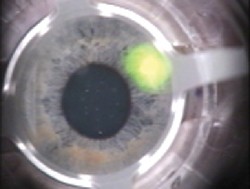 |
Q: How does bladeless flap surgery for refractive correction differ from standard microkeratome flaps in LASIK, and what are the benefits and pitfalls of it?
A: Bladeless flap surgery differs from LASIK in that a silent computer-guided laser called IntraLase is used to create lamellar flaps instead of a hand-held microkeratome blade. In addition, the flaps are made in both eyes first, taking slightly longer (about a minute more) than LASIKs hand-held microkeratome blade, says optometrist Tracy Swartz, of Nashville. The patient is then moved under the excimer laser for ablation.
There are four apparent benefits of this technology:
The cornea is not traversed. Microkeratomes traverse the cor- nea, which may disrupt the epithelium, says Dr. Swartz. In bladeless refractive surgery, the cone tip applanates the cornea, touching it centrally, which when done correctly rarely roughens the cornea, she says.
A consistent flap thickness is produced. The IntraLase laser provides the surgeon with greater control over the flap thickness with an error of approximately 10m. The standard of error with mechanical microkeratomes in the actual thickness of the flap may be large, which could pose a problem for patients with high myopia/thin corneas and who require significant ablation, Dr. Swartz says.
The stromal bed is never tilted. The flaps made by microkeratomes are thinner at the edges, and the resulting stromal bed may be tilted if the microkeratome is not placed correctly. This could induce astigmatism, Dr. Swartz says.
A: Bladeless flap surgery differs from LASIK in that a silent computer-guided laser called IntraLase is used to create lamellar flaps instead of a hand-held microkeratome blade. In addition, the flaps are made in both eyes first, taking slightly longer (about a minute more) than LASIKs hand-held microkeratome blade, says optometrist Tracy Swartz, of Nashville. The patient is then moved under the excimer laser for ablation.
There are four apparent benefits of this technology:
The cornea is not traversed. Microkeratomes traverse the cor- nea, which may disrupt the epithelium, says Dr. Swartz. In bladeless refractive surgery, the cone tip applanates the cornea, touching it centrally, which when done correctly rarely roughens the cornea, she says.
A consistent flap thickness is produced. The IntraLase laser provides the surgeon with greater control over the flap thickness with an error of approximately 10m. The standard of error with mechanical microkeratomes in the actual thickness of the flap may be large, which could pose a problem for patients with high myopia/thin corneas and who require significant ablation, Dr. Swartz says.
The stromal bed is never tilted. The flaps made by microkeratomes are thinner at the edges, and the resulting stromal bed may be tilted if the microkeratome is not placed correctly. This could induce astigmatism, Dr. Swartz says.
 |
| In bladeless refractive surgery, a computer-guided laser is used. |
Better visual acuity is achieved. Ophthalmologist Vance Thompson, of Sioux Falls, S. D., says that patients on whom he has used Intra- Lase have ended up with better visual acuity and less induction of higher-order aberrations than those who underwent standard LASIK.
The computer-guided laser creates a planar flap, and I believe that this planar flap is the reason patients who undergo this procedure are having less of an induction of higher-order aberrations and, thus, better outcomes visually, he says. Another reason these patients may be having better visual outcomes is because the bladed flaps drag the tear film debris and fluid into the interface, whereas the bladeless procedure does not because the hydration is very well controlled.
Optometrist James Thimons, of Fairfield, Conn., adds that while study data show similar findings, he is not a believer. The data I have seen have shown that these patients have had some minor improvements, but I think that some of that comes from the fact that these clinical trials were in highly controlled settings, he says.1,2
So, what are the pitfalls of Intra-Lase?
Vision for those who undergo this procedure may be slightly reduced the first day after sur-gery because the flaps may not be as clear as microkeratome flaps, says Dr. Swartz. She adds that she has seen a higher frequency of diffuse lamellar keratitis (DLK) and transient light sensitivity (TLS) in these patients.
Dr. Thompson says office space could be an issue. I have my laser to do the vision correction and the laser flap in the same room, he says. You just have to build a room to fit both.
The cost of IntraLase is a pitfall, says Dr. Thimons. The laser costs $375,000. I think the bladeless surgery technology is great, he says, but you have to ask yourself, can I get that money back? The answer is you might be able to.
The computer-guided laser creates a planar flap, and I believe that this planar flap is the reason patients who undergo this procedure are having less of an induction of higher-order aberrations and, thus, better outcomes visually, he says. Another reason these patients may be having better visual outcomes is because the bladed flaps drag the tear film debris and fluid into the interface, whereas the bladeless procedure does not because the hydration is very well controlled.
Optometrist James Thimons, of Fairfield, Conn., adds that while study data show similar findings, he is not a believer. The data I have seen have shown that these patients have had some minor improvements, but I think that some of that comes from the fact that these clinical trials were in highly controlled settings, he says.1,2
So, what are the pitfalls of Intra-Lase?
Vision for those who undergo this procedure may be slightly reduced the first day after sur-gery because the flaps may not be as clear as microkeratome flaps, says Dr. Swartz. She adds that she has seen a higher frequency of diffuse lamellar keratitis (DLK) and transient light sensitivity (TLS) in these patients.
Dr. Thompson says office space could be an issue. I have my laser to do the vision correction and the laser flap in the same room, he says. You just have to build a room to fit both.
The cost of IntraLase is a pitfall, says Dr. Thimons. The laser costs $375,000. I think the bladeless surgery technology is great, he says, but you have to ask yourself, can I get that money back? The answer is you might be able to.
1. Kezirian GM, Stonecipher KG. Comparison of the IntraLase femtosecond laser and mechanical keratomes for laser in situ keratomileusis. J Cataract Refract Surg 2004 Apr;30(4):804-11.
2. Greater Precision for Better Safety and Outcomes. The InraLase FS laser makes LASIK better. www.intralase.com/physician/outcomes/index.html. (28 Jan. 2005)
Vol. No: 142:2Issue:
2/15/05

